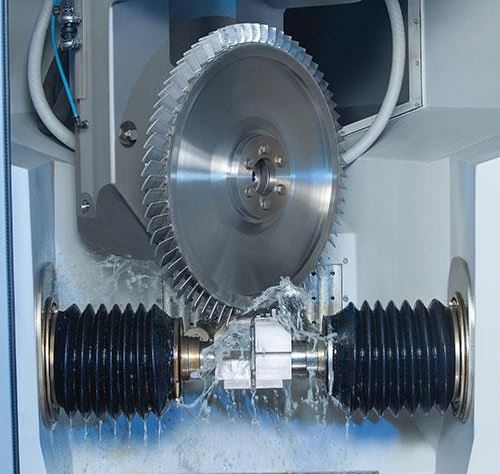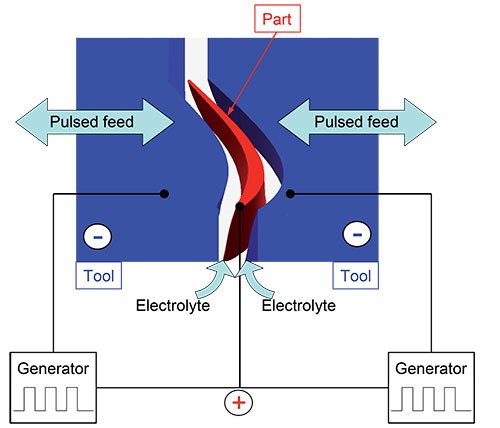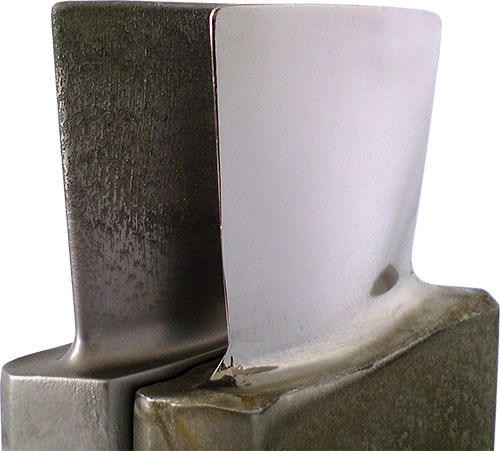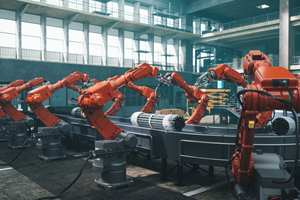An Electrochemical Option for Blisks, Blades
This machining platform offers the non-contact electrochemical/precision electrochemical processes for five-axis milling of turbine engine blades and blisks.
Share




There are two primary compressor rotor designs for modern turbine engines. The first features separate disk and blade components. For this design, individual, contoured blades install around a disk’s periphery by fitting into precisely machined root-form slots. The second is a “blisk” design, in which a disk and its peripheral blade profiles are machined from a single billet of material. Because of the extreme heat generated in the high-pressure compressor area of a turbine engine, these components are commonly manufactured from titanium or high-nickel-content alloys, such as Inconel.
Five-axis machine tools are commonly used to rough and finish-machine blisks and blades. However, Jonathan Chomicz, a technology specialist for German machine tool builder Emag, notes that an alternate, non-contact machining process can be more productive for these applications. This process combines an electrochemical machining (ECM) roughing operation and a precision electrochemical machining (PECM) finishing operation on the Emag PO 900 BF machine platform. Chomicz says ECM/PECM offers 10- to 30-percent faster cycle times than conventional five-axis machining of blades and blisks, does not create burrs, and achieves fine surface finishes to 0.05 Ra.
Both ECM and PECM remove metal through electrolysis, whereby the conductive workpiece is the positive anode and the tool is the negative cathode. The DC charge that crosses the electrolyte-flushed gap between the two causes the molecular erosion of the workpiece. Thermally neutral, the ECM/PECM processes can effectively machine the otherwise challenging-to-mill materials that comprise blades and blisks with no recast layer and minimal tool wear. In fact, it’s not unusual for tools commonly made from brass or 304 stainless steel to produce 4,000 to 5,000 parts during a production run, Chomicz says.
That said, PECM differs from ECM in a few ways. PECM features a synchronized oscillating tool motion to ensure that the electrolyte is properly replaced and renewed. The gap between the tool and the workpiece through which the electrolyte is flushed is narrower, too. A narrower gap offers a more effective arrangement of electrical field lines and results in more accurately machined profiles. PECM also uses a pulsed voltage power source to facilitate current flow across the gap during the tool movement. The “on” pulse creates higher current densities to deliver improved machining accuracy. The “off” pulse assists in electrolyte exchange and heat dissipation, which is why better surface finishes are possible.
During finishing of blade profiles, the PECM process uses two tools to machine both sides of the profile simultaneously (see the drawing). Plus, scaling of tools and power supply enables large blades and blisks to be machined at the same feed rates and cycle times as smaller ones. Accurate monitoring and adjustment of voltage, current and electrolyte flow offer optimal process stability, Chomicz says, while an electrolyte management system ensures that electrolyte properties such as pH, conductance, temperature and purity remain constant.
The Emag PO 900 BF machine platform offers power ranging to 20,000A DC and a pulse rate of 30,000A. It can accommodate blisks as large as 900 mm in diameter and single blades as tall as 250 mm.
Related Content
Bavius Technologie Appoints New President, Schedules Technology Showcase
Roy D. Cripps will lead the team at Bavius as it aims to expand its current business in aerospace structures and develop new market segments. Additionally, the company will showcase its technology during an open house event on June 11.
Read MoreHow a Custom ERP System Drives Automation in Large-Format Machining
Part of Major Tool’s 52,000 square-foot building expansion includes the installation of this new Waldrich Coburg Taurus 30 vertical machining center.
Read MoreIncreasing OEM Visibility to Shopfloor Operations for the Win
A former employee of General Motors and Tesla talks about the issues that led to shutdowns on factory lines, and what small- to medium-sized manufacturers can do today to win business from large OEMs.
Read MoreSandvik Coromant Inserts Provide Stable Turning of Aerospace Components
The new insert grades GC1205 and GC1210 cover a large application area within last-stage machining and intermediate-stage machining when turning aerospace engine components.
Read MoreRead Next
5 Rules of Thumb for Buying CNC Machine Tools
Use these tips to carefully plan your machine tool purchases and to avoid regretting your decision later.
Read MoreSetting Up the Building Blocks for a Digital Factory
Woodward Inc. spent over a year developing an API to connect machines to its digital factory. Caron Engineering’s MiConnect has cut most of this process while also granting the shop greater access to machine information.
Read MoreRegistration Now Open for the Precision Machining Technology Show (PMTS) 2025
The precision machining industry’s premier event returns to Cleveland, OH, April 1-3.
Read More





























.jpg;maxWidth=300;quality=90)








